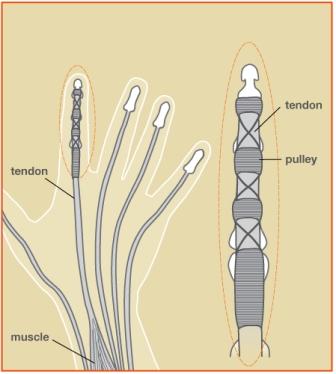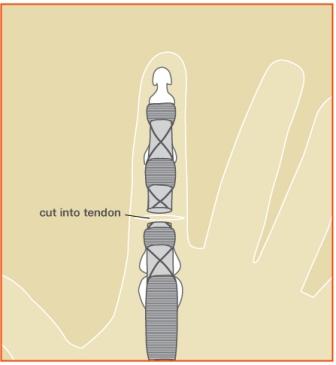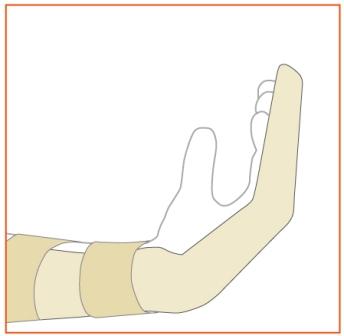Flexor tendons in the hand and forearm
The muscles that bend (flex) the fingers are called flexor muscles. These flexor muscles move the fingers through cord-like extensions called tendons, which connect the muscles to bone. The flexor muscles start at the elbow and forearm regions, turn into tendons just past the middle of the forearm, and attach to the bones of the fingers (see Figure 1). In the finger, the tendons pass through fibrous rings called pulleys, which guide the tendons and keep them close to the bones, enabling the tendons to move the joints much more effectively.
Deep cuts on the palm side of the wrist, hand, or fingers can injure the flexor tendons and nearby nerves and blood vessels. The injury may appear simple on the outside, but is actually much more complex on the inside. When a tendon is cut, it acts like a rubber band, and its cut ends pull away from each other. A tendon that has not been cut completely through may still allow the fingers to bend, but can cause pain or catching, and may eventually tear all the way through. When tendons are cut completely through, the finger joints cannot bend on their own (see Figure 2).
How are flexor tendon injuries treated?
Tendon Healing
Tendons are made of living cells. If the cut ends of the tendon can be brought back together, healing begins through the cells that are inside of the tendon as well as the tissue outside of the tendon. Because the cut ends of a tendon usually separate after an injury, a cut tendon can not heal without surgery.
Your doctor will advise you on how soon surgery is needed after a flexor tendon is cut. There are many ways to repair a cut tendon, and certain types of cuts need a specific type of repair. In the finger, it is important to preserve certain pulleys, and there is very little space between the tendon and pulley in which to perform a repair. Nearby nerves and blood vessels may need to be repaired as well. After surgery, and depending on the type of cut, the injured area can either be protected from movement or started on a very specific limited-movement program for several weeks (see Figure 3). Your doctor may prescribe hand therapy for you after surgery. If unprotected finger motion begins too soon, the tendon repair is likely to pull apart. After four-to-six weeks, the fingers are allowed to move slowly and without resistance. Healing takes place during the first three months after the repair.
In most cases, full and normal movement of the injured area does not return after surgery. If it is hard to bend the finger using its own muscle power, it could mean that the repaired tendon has pulled apart or is bogged down in scar tissue. Scarring of the tendon repair is a normal part of the healing process. But in some cases, the scarring can make bending and straightening of the finger very difficult. Depending on the injury, your doctor may prescribe therapy to loosen up the scar tissue and prevent it from interfering with the finger’s movement. If therapy fails to improve motion, surgery to release scar tissue around the tendon may be required.
Hand Therapy After Surgery
If a program of controlled, limited motion is selected as therapy for the first several weeks after surgery, it is important to work closely with a hand therapist and your surgeon to understand the therapy and follow set guidelines. The tendon repair might pull apart if your hand is used too soon or if therapy guidelines are not followed. In addition to regaining motion of the finger after a tendon injury, therapy will be helpful in softening scars and building grip strength.
 Figure 1: The tendons of the hand run from the flexor muscles in the elbow and forearm to the bones of the fingers
Figure 1: The tendons of the hand run from the flexor muscles in the elbow and forearm to the bones of the fingers
 Figure 2: When flexor tendons are completely cut, the finger cannot be bent
Figure 2: When flexor tendons are completely cut, the finger cannot be bent
 Figure 3: After surgery, the area of the injured tendon must be protected from movement
Figure 3: After surgery, the area of the injured tendon must be protected from movement
Download the PDF on Flexor Injuries



